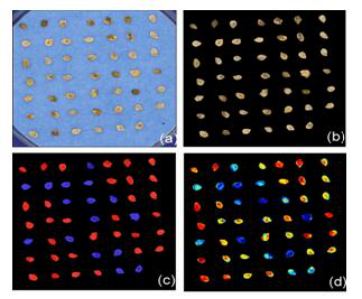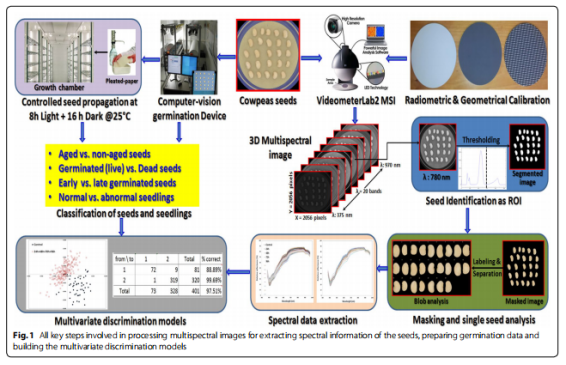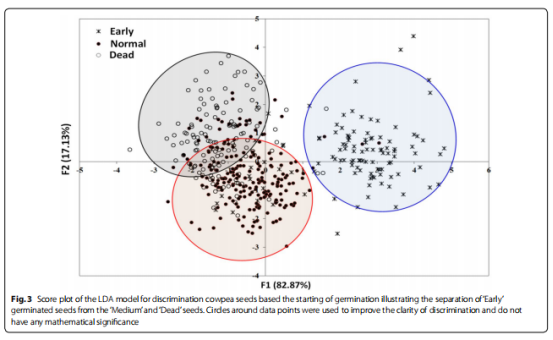品质至上,客户至上,您的满意就是我们的目标
技术文章
当前位置: 首页 > 技术文章
基于图谱合一多光谱成像图像技术在种子分类中的应用
发表时间:2020-08-04 08:40:27点击:1441
来源:北京博普特科技有限公司
分享:
种子是农业生产中较基本,较重要的生产资料,作为一切农业生产的基础,它的纯度关乎整个农业产业的发展。种子的特征是种子种类识别的主要依据。近年来,随着杂交技术的广泛应用,种子的种类数目越来越来多,随之而来的种子混杂现象越来越严重。因此,保证种子的纯度是一个亟待解决的问题。多光谱成像技术囊括了计算机机器视觉的图像信息和近红外光谱的光谱信息两种特征信息,是一种无损检测的图谱合一新方法,在此领域中多光谱图像技术得到了广泛的应用。利用多光谱图像技术结合数字图像处理及多元数据分析技术,提取多光谱图像中感兴趣区域特征,建立种子分类模型,实现对种子品种的高精度自动识别,多光谱成像系统的应用对种子品种识别,保证种子质量具有重要的实际应用价值。
种子成熟度是测定种子质量较重要的一个标准,成熟种子拥有强劲的发芽能力,与未成熟种子相比,较能承受胁迫。但基于果实发育阶段,很难测定番茄种子成熟度。以前对与叶绿素含量相关种子外壳颜色研究表明其与种子成熟度存在正相关。
图1. 番茄种子多光谱成像 (a), 背景分离(b)。每个种子标识为“萌发” (红色) 或 “未萌发” (蓝色) -基于在第7天的发芽统计(c) ; nCDA-转换图像(d)。

图1
多光谱成像技术是一种新出现的技术,可应用在种子科学领域,在番茄变化识别上取得了良好的结果。同时我们用化学计量法-标准化的典型判别分析(nCDA)检查了MSI测量番茄种子成熟度的适用性。图2. nCDA 区分训练集萌发和未萌发的番茄种子(a), 来自青番茄和红番茄的种子(b),横线 (-) 指示了分类的阈值。

图 2
结果表明多光谱成像在种子成熟度测量上的潜力。结果显示种子成熟度测量应该基于种子而非果实成熟或颜色的判断。我们会进一步研究来观测在正常生长条件下的来自青番茄的成熟种子性能。研究链接参见ISTA_Poster_Santosh_For_Print-min.pdf
Use of multispectral images and chemometrics in tomato seed studies
Seed maturity is one of the important criteria for determining the seed quality as the mature seeds possess higher ability to germinate and withstand stresses as compared to immature seeds. However, it is difficult to determine the tomato seed maturity based on the developmental stage of the fruit.1 .Previous studies on seed coat colour pertaining to the chlorophyll content have shown positive correlation with seed maturity.2
Multispectral imaging (MSI) in seed science is an emerging technology and has shown promising results for tomato varietal identification.3 We further aim to examine the applicability of MSI to determine the tomato seed maturity using chemometric method normalised canonical discriminant analyses (nCDA)
The study demonstrates the potential of multispectral imaging for seed maturity determination. The result suggests seed maturity determination should be based on seeds instead of judging by fruit maturity or colour. However, further investigation would be required to see performance of the mature seeds from the green tomatoes under normal growing conditions.
小麦识别:为了研究多光谱成像技术对小麦品种快速无损鉴定的可行性,采用VideometerLab多光谱图像采集设备对5个小麦品种共500个样品在405~970 nm波段内的进行多光谱图像信息进行采集,获取其光谱、颜色和形态特征。利用主成分分析对5个小麦品种进行定性鉴别,同时,基于光谱特征和光谱图像特征分别比较了神经网络、支持向量机和随机森林3种模型的鉴定效果。结果显示:利用19个光谱特征值建立的模型中,BPNN识别模型效果较佳,其建模集和预测集的识别率分别为100%和91.25%。融合19个光谱特征和6个图像特征所建立的模型中,BPNN识别模型效果较佳,其建模集和预测集的识别率分别达到了100%和98.4%。结果表明,基于BPNN的多光谱特征融合能够有效的提高小麦品种鉴定效率,为小麦品种的快速无损检测提供了一个新途径。
稻谷品种识别:稻谷品种的误鉴别是造成中国稻谷经济损失的重要原因之一。传统稻谷品种鉴别的方法主要有形态学方法、荧光扫描鉴定法、化学鉴定法和电泳鉴定法等。形态学方法鉴别所需时间长,精度不高;荧光扫描鉴定法、化学鉴定法和电泳鉴定法等精度高,但所需时间长,鉴别过程烦琐,需要专业人员操作,不适宜对样品进行批量分析和无损在线监测。近年来,近红外光谱技术在稻谷鉴别中有了一定的研究,但近红外光谱所检测的区域通常是样品表面的某点或较小区域的近红外透射、漫反射信息,缺少对象的空间信息,可能会影响系统的稳定性。因此,稻谷品种的快速无损鉴别仍是目前农业产后研究领域的难点多光谱成像技术是一种图像和光谱的融合技术,可同时获取对象的空间信息及光谱信息,在农产品无损检测领域有着广泛研究,如黄瓜的冷害检测,正常小麦与受损小麦的识别正常麦粒和萌芽的或已发芽麦粒的区分,大麦、小麦和玉米中杂质的剔除,玉米粒中黄曲霉毒素感染的检测等。虽然光谱信息与农产品品质有着一定的相关性,并取得了一些研究成果,但由于光谱信息是高维数据,如何建立光谱与农产品品质之间的模型仍是一个开放问题。
通过对稻谷不同波长光谱反射率的测量,结合稻谷图像特征,建立基于较小二乘支持向量机的稻谷品种鉴别模型,利用粒子群优化算法进行SVM参数寻优,以期为稻谷品种的快速、无损鉴别提供一种方法。光谱测定采用VideometerLab多光谱测量仪检测光谱405、435、450、470、505、525、570、590、630、645、660、700、780、850、870、890、910、940和970nm19个波长。
豇豆种子分类:传统评估种子的方法通常是先进行有损取样,然后进行物理、生理、生化和分子测定。这些方法的确是有效的,但其对种子进行了破坏,并且耗时耗力,还需要有经验的种子分析师。本文研究的目的是探讨机器视觉和多光谱成像系统在高通量豇豆种子分类中的应用潜力。利用自动机器视觉发芽系统在种子吸胀和发芽期间不间断地监测,来识别所有单个种子的不同类别。本文利用从多光谱图像中提取的单个豇豆种子的光谱特征,建立了基于线性判别分析(LDA)的多变量分析模型,根据种子的老化程度、活力程度、幼苗生长状况和发芽速度将种子分为不同的类别。
法国科学家利用VideometerLab 3多光谱成像系统对豇豆种子进行分类研究,Videometerlab多光谱成像系统是较较好的多光谱成像系统以及种子表型、种质资源库建设工具。
背景:传统种子评估方法通常用破坏性取样方法,之后进行机械、生理、生物化学和分子检测。尽管证实有效,此类方法广受质疑的一点是具有破坏性,耗时、耗力、需要有经验种子分析人员参与。该研究的目标是探讨计算机视觉以及多光谱成像系统结合多变量分析法在高通量鉴别豇豆种子上的应用。研究中采用了自动机器视觉生成系统(VideometerLab3),无间断监控种子(休眠和萌发阶段)来区分不同类别的单个种子。利用从多光谱图像中提取的单个豇豆种子的光谱特征,开发了基于线性判别式分析(LDA)的不同多变量分析模型,依据年龄、活力、发芽条件以及发育速度将种子进行分类。
结果: 结果显示LDA 模型在区分“老化”和“非老化”种子方面的全面正确区分率(OCC) 分别达到97.51, 96.76一级97%, ‘发芽’和‘非发芽‘种子全面正确区分率为81.80,79.05和81.0%,‘初步萌发’, ‘中度萌发’和‘死’种子的OCC分别为77.21,74.93以及68.00%。在给出“正常”以及“异常”发芽的训练集、交叉验证以及独立验证数据集的OCC值分别为68.08, 64.34以及62.00%。研究开发了图像处理流程,利用像素区分模型,探索多光谱成像系统在对不同类种子视觉区分的应用潜力。
结论: 结果显示多光谱成像系统可在紫外、可见光以及短波近红外波段提供必要的将单个豇豆种子区分到不同类别的信息。考虑到拍摄时间短以及制备样品有限等情况,该先进的多光谱成像方法以及化学计量分析法对需要在线对种子进行经济分类、实时分拣以及评级过程来说较有价值,系统不仅提供了形态学和物理学特征,还提供了检测种子的化学信息。开发执行针对种子品质检测的图像处理算法、降低成本并增加计算机硬件的使用,在种子品质自动检测领域使用计算机集成系统将对业界有巨大吸引力。


Utilization of computer vision and multispectral imaging techniques for classifcation of cowpea (Vigna unguiculata) seeds
Gamal ElMasry1,4, Nasser Mandour1, Marie Hélène Wagner2, Didier Demilly2, Jerome Verdier4, Etienne Belin3,4 and David Rousseau
Abstract
Background: The traditional methods for evaluating seeds are usually performed through destructive sampling followed by physical, physiological, biochemical and molecular determinations. Whilst proven to be efective, these approaches can be criticized as being destructive, time consuming, labor intensive and requiring experienced seed analysts. Thus, the objective of this study was to investigate the potential of computer vision and multispectral imaging systems supported with multivariate analysis for high-throughput classifcation of cowpea (Vigna unguiculata) seeds. An automated computer-vision germination system was utilized for uninterrupted monitoring of seeds during imbibition and germination to identify diferent categories of all individual seeds. By using spectral signatures of single cowpea seeds extracted from multispectral images, diferent multivariate analysis models based on linear discriminant analysis (LDA) were developed for classifying the seeds into diferent categories according to ageing, viability, seedling condition and speed of germination.
Results: The results revealed that the LDA models had good accuracy in distinguishing ‘Aged’ and ‘Non-aged’ seeds with an overall correct classifcation (OCC) of 97.51, 96.76 and 97%, ‘Germinated’ and ‘Non-germinated’ seeds with OCC of 81.80, 79.05 and 81.0%, ‘Early germinated’, ‘Medium germinated’ and ‘Dead’ seeds with OCC of 77.21, 74.93 and 68.00% and among seeds that give ‘Normal’ and ‘Abnormal’ seedlings with OCC of 68.08, 64.34 and 62.00% in training, cross-validation and independent validation data sets, respectively. Image processing routines were also developed to exploit the full power of the multispectral imaging system in visualizing the diference among seed categories by applying the discriminant model in a pixel-wise manner.
Conclusion: The results demonstrated the capability of the multispectral imaging system in the ultraviolet, visible and shortwave near infrared range to provide the required information necessary for the discrimination of individual cowpea seeds to diferent classes. Considering the short time of image acquisition and limited sample preparation, this stat-of-the art multispectral imaging method and chemometric analysis in classifying seeds could be a valuable tool for on-line classifcation protocols in cost-efective real-time sorting and grading processes as it provides not only morphological and physical features but also chemical information for the seeds being examined. Implementing image processing algorithms specifc for seed quality assessment along with the declining cost and increasing power of computer hardware is very efcient to make the development of such computer-integrated systems more attractive in automatic inspection of seed quality.
北京博普特科技有限公司是丹麦Videometer公司中国区总代理,全面负责其系列产品在中国市场的推广、销售和售后服务。